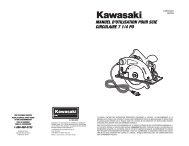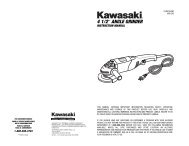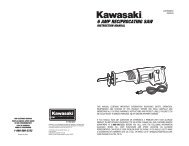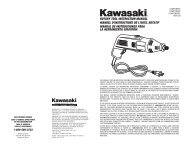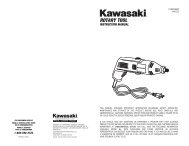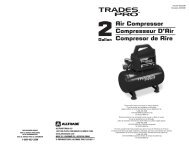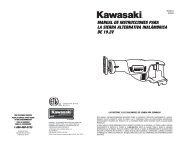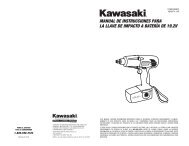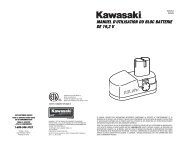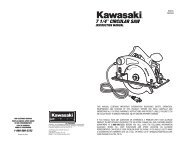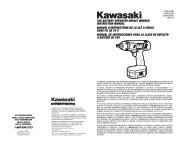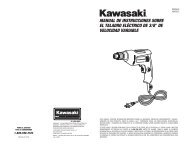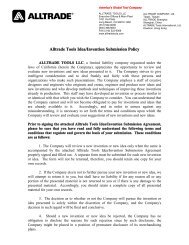Kawasaki 19.2V Cordless Drill - Alltrade Tools
Kawasaki 19.2V Cordless Drill - Alltrade Tools
Kawasaki 19.2V Cordless Drill - Alltrade Tools
- No tags were found...
You also want an ePaper? Increase the reach of your titles
YUMPU automatically turns print PDFs into web optimized ePapers that Google loves.
Check the operation and condition of the lower guard spring. If the guard andthe spring are not operating properly, they must be serviced before use. Lowerguard may operate sluggishly due to damaged parts, gummy deposits, or abuildup of debris.Lower guard should be retracted manually only for special cuts such as“Pocket Cuts” and “Compound Cuts.” Raise lower guard by RetractingHandle. As soon as the blade enters the material, lower guard must bereleased. For all other sawing, the lower guard should operate automatically.Always observe that the lower guard is covering the blade before placingsaw down on bench or floor. An unprotected, coasting blade will cause the sawto walk backwards, cutting whatever is in its path. Be aware of the time it takesfor the blade to stop after the switch is released.NEVER hold piece being cut in your hands or across your leg. It is important tosupport the work properly to minimize body exposure, blade binding, or loss of control.Hold tool by insulated gripping surfaces when performing an operationwhere the cutting tool may contact hidden wiring. Contact with a “live” wirewill also make exposed metal parts of the tool “live” and shock the operator.When ripping always use a rip fence or straight edge guide. This improvesthe accuracy of the cut and reduces the chance for blade binding.Always use blades with correct size and shape (diamond vs. round) arborholes. Blades that do not match the mounting hardware of the saw will runeccentrically, causing loss of control.Never use damaged or incorrect blade washers or bolts. The blade washersand bolts were specifically designed for your saw, for optimum performanceand safety of operation.SAFETY RULES FOR CIRCULAR SAWNEVER assume the blade has stopped just because the trigger has beenreleased. Blades may continue moving even after the motor stops.Always wear safety goggles or eye protection when using this tool. Use adust mask or respirator for applications which generate dust. This saw maythrow up debris that could lodge in the eyes causing severe pain or injury.Inspect the bolts and blade washers before each use. Damaged or incorrectbolts or blade washers can cause injury.7When using the Circular Saw, always maintain a firm grip on the tool withboth hands. Never put your hands or feet in the cutting area. Do not graspthe tool or place your hands too close to the blade. Keep your hands well awayfrom the blade. Never reach underneath the tool while the blade is in motion.Do not use your legs or feet to stabilize the work piece.Keep the handle of the <strong>Cordless</strong> Circular Saw dry, clean and free from oil andgrease.Do not run the <strong>Cordless</strong> Circular Saw while carrying it at your side. A movingblade could cause serious personal injury.Disconnect battery pack from tool and place the switch in the locked or“OFF” position before making any assembly adjustments, changing accessories,performing any inspection, maintenance or cleaning procedures. Suchpreventive safety measures reduce the risk of starting the tool accidentallywhich could cause serious personal injury.Be extra careful when cutting in high or hard-to-reach locations. Avoid sawingoverhead. Be on the lookout for hidden wires and falling debris.Do not use the <strong>Cordless</strong> Circular Saw if it has been damaged, left outdoorsin the rain, snow, wet or damp environments, or immersed in liquid.Maintain labels and nameplates on the <strong>Cordless</strong> Circular Saw. These carryimportant information. If unreadable or missing, contact <strong>Alltrade</strong> for a replacement.CAUSES AND PREVENTION OF KICKBACKKickback is a sudden reaction to a pinched, bound, or misaligned saw blade,causing an uncontrolled saw to lift up and out of the work piece toward theoperator.When the blade is pinched or bound tightly by the kerf closing down, the bladestalls and the motor reaction drives the unit rapidly back toward the operator.If the blade becomes twisted or misaligned in the cut, the teeth at the back edgeof the blade can dig into the top surface of the wood causing the blade to climbout of the kerf and jump back toward the operator.Kickback is the result of tool misuse and/or incorrect operating procedures orconditions and can be avoided by taking proper precautions as given below:Maintain a firm grip on the saw and position your body and arm in a way thatallows you to resist KICKBACK forces. KICKBACK forces can be controlled bythe operator, if proper precautions are taken.



